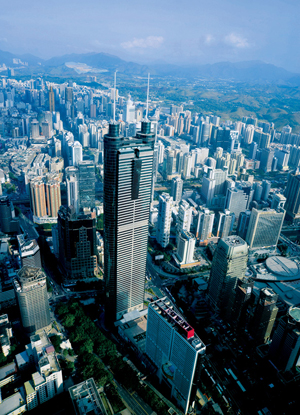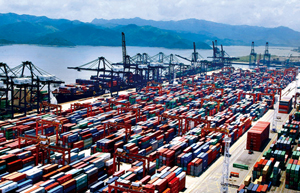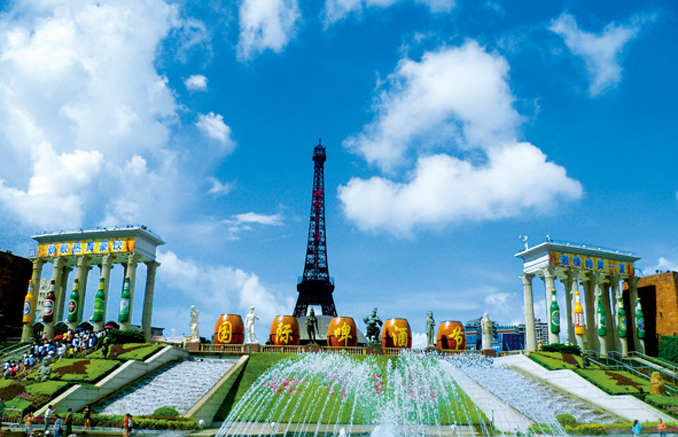
Written by: Cai Tingting
Posted on: July 02, 2013 |  | 中文
| 中文
Shenzhen - City of Miracles
25 years ago, Shenzhen, a metropolis of China today, was just a fishing village. From 1980 to 2001, its GDP has witnessed an average annual growth of 29.5%, surpassing the former Federal Republic of Germany, Japan, and the “Four Tigers” in Asia in their most prosperous times. Shenzhen people have a very fast pace in their life and work. Everyone of the city works very hard for a new life. It is a young city where the average age of its citizens is only 30.8. And now, one can see theme parks in the city, which are well-known not only in the country but also in the world. Now the city is a place of fun and joy.
 |
| Bird's eye view of Shenzhen Special Economic Zone |
In China, there is a legendary city called “Shenzhen.” It is also called “Pengcheng”, meaning “a city like a great eagle flying in the sky.” 25 years ago, Shenzhen was a fishing village. Now it has become a metropolis. From 1980 to 2001, its GDP has witnessed an average annual growth of 29.5%, surpassing the former Federal Republic of Germany, Japan, and the “Four Tigers” in Asia in their most prosperous times. Economists view this phenomenon as “a world economic miracle.” In the first few years of the new century, its annual GDP per capita has reached 5,000 US dollars while its comprehensive economic capacity developed to the level of an upper-middle income country of the world.
Shenzhen, a seashore city in South China, is located in the southern part of Guangdong Province, bordering Hong Kong. Historically, Shenzhen was an important sea-lane trade hub of South China and was famous for its abundant salt, spices, tea, pearls, etc. In the late 14th century, Chinese ships headed for the South China Sea often would visit the area around Shenzhen to pray for luck before sailing.
Shenzhen City was founded in 1979, and in 1980, guided by the reform and opening policies of China, Chinese leader Deng Xiaoping decided to make it a Special Economic Zone (SEZ). It became one of the earliest areas of the country in which the reform and opening policies were experimented with. Deng Xiaoping visited Shenzhen in 1984 and he was very pleased to see its fast development. He encouraged the city to go ahead for more experiment of reform and opening, and to dare to strive for innovations in its development. With the correct decisions and preferential policies, plus the large amount of investments from Hong Kong, Taiwan, and Japan, the city started with unprecedented investments on its various projects for development, and it is only in 20 years that Shenzhen has developed into an international metropolis. The speed of its development can be seen from the slogan of the Shenzhen people “Time is money, efficiency is life,” which greatly influenced the China of the 1980s. Shenzhen SEZ is the window opening to the outside world, from which China learned advanced techniques and knowledge and management experiences from other countries. For the past several years, the experiences developed by Shenzhen have been spreading all over China. And Shenzhen has contributed enormously to China’s reform and opening.
Shenzhen is a transportation hub on the South China coast. It has 12 ports, and Shenzhen airport is among the top 4 airports of China and is the No.4 container airport of the world. Besides, Shenzhen has China’s biggest land passenger port. Its favorable geographical position makes it an important communicative hub for connecting China and the world market and for the country’s foreign trade. Its total export volume has been on the top among all the mainland large and middle-sized cities for 15 years. The city now is the most important base of China’s R&D and production and the trading center for high-tech products, including computer, software, communication equipment, audiovisual product, optical-electro-mechanical product, biopharmaceutical products, and medical devices. Its total output of television and computer sets ranks the first in China; its output of stored-program control exchange takes up 80% of China’s total; its export volume of computer software has been China’s No.1 for many years; its output of injection molding machines ranks the top in Asia. In addition, the city produces the largest number of containers and digital multimeters in the whole world, and it is also the world’s biggest production base for clock and watch parts.
 |
| Shenzhen port |
Shenzhen people enjoy a very fast pace in their life and work. Everyone in the city works very hard for a new life. The city’s annual GDP per capita (except the cities whose major industry is petrol production), its annual disposable income of per urban household, and total export volume all rank the first in China. Shenzhen is the first city of China that has been built based on the overall plan for urban constructions. Its total landscaping area covers an area of nearly 20,000 hectares while it has a green coverage of 45%, providing a harmonious and eco-friendly environment for both its citizens and nature. In December 2000, in the final session of the international “Garden City” competition for the year of 2000, Shenzhen won the award of the first place of Group E (population over one million) in Washington D.C. USA. In 2002, the city was awarded the title of one of “the Globe’s 500 of Best Environment” by UNEP.
Shenzhen is a new city of immigrants. For the past 25 years people with all sorts of talents have fought to realize their dreams in this place. The population of the city in March, 1979 was only 314,100, but by the end of August, 2005, it had reached to almost 10 million with 8 million of them being immigrants from all over China. Shenzhen is such a young city that the average age of its citizens is only 30.8. It is also a city inhabited by people from 55 ethnic nationalities of China.
Shenzhen is not only a city for business but also one for fun. Theme parks are one of the must-visit destinations for travelers. “Splendid China Park” is the place for one to “take a closer look at the history and travel around China in one day.” It is one of the first theme parks in China. Miniatures of famous Chinese historical and cultural heritages and sites are seen here, such as the Great Wall, the Forbidden City, the landscape of the Lijiang River, sceneries of West Lake, etc. These miniatures are just like the real ones in form, providing the visitors with an unforgettable experience. “Chinese Folk Culture Village” offers various cultural activities of different folk customs, songs and dances of different ethnic peoples for visitors. The village not only exhibits the culture, customs, and traditional life activities of the Chinese people but also offers all kinds of famous ethnic cuisines. Last but not least is the “Window of the World Park” which is an assembly of exotic attractions and a gathering of all the cultural heritages of the world. In addition, the city’s tourist sites and facilities are also full of charm. They are famous for their unique and novel styles.
 |
| The Window of the World park |
Recommended Tour Route: Tourists may tour the Window of the World Park” and “the Splendid China Park” in the morning and have a lunch, enjoying cuisines from all over the world in the parks. Then they may go to the “Chinese Folk Culture Village” in the afternoon, enjoy the ethnic cuisine, watch performances and stay at the village for the night.
Introduction of the Tourist Sites: There are miniatures of the wonders of the world and heritages and folk dance performances in the Window of the World Park. There are copied scenarios of Chinese heritages and sites of interests in the Splendid China Park, and in the Chinese Folk Culture Village one can see the daily life and architectures of 56 ethnic peoples of China.
A little heads up: The subway system of Shenzhen is top notch and China’s best. Do not hesitate to give it a try!
You may also like: